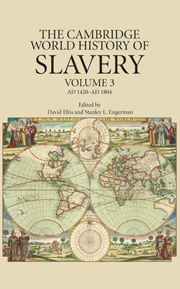Book contents
- Frontmatter
- Contents
- List of Maps, Figures, and Tables
- Contributors
- Series Editors' Introduction
- 1 Dependence, Servility, and Coerced Labor in Time and Space
- PART I SLAVERY IN AFRICA AND ASIA MINOR
- PART II SLAVERY IN ASIA
- 7 Slavery in Southeast Asia, 1420–1804
- 8 Slavery in Early Modern China
- PART III SLAVERY AMONG THE INDIGENOUS AMERICANS
- PART IV SLAVERY AND SERFDOM IN EASTERN EUROPE
- PART V SLAVERY IN THE AMERICAS
- PART VI CULTURAL AND DEMOGRAPHIC PATTERNS IN THE AMERICAS
- PART VII LEGAL STRUCTURES, ECONOMICS, AND THE MOVEMENT OF COERCED PEOPLES IN THE ATLANTIC WORLD
- PART VIII SLAVERY AND RESISTANCE
- Index
8 - Slavery in Early Modern China
from PART II - SLAVERY IN ASIA
Published online by Cambridge University Press: 28 September 2011
- Frontmatter
- Contents
- List of Maps, Figures, and Tables
- Contributors
- Series Editors' Introduction
- 1 Dependence, Servility, and Coerced Labor in Time and Space
- PART I SLAVERY IN AFRICA AND ASIA MINOR
- PART II SLAVERY IN ASIA
- 7 Slavery in Southeast Asia, 1420–1804
- 8 Slavery in Early Modern China
- PART III SLAVERY AMONG THE INDIGENOUS AMERICANS
- PART IV SLAVERY AND SERFDOM IN EASTERN EUROPE
- PART V SLAVERY IN THE AMERICAS
- PART VI CULTURAL AND DEMOGRAPHIC PATTERNS IN THE AMERICAS
- PART VII LEGAL STRUCTURES, ECONOMICS, AND THE MOVEMENT OF COERCED PEOPLES IN THE ATLANTIC WORLD
- PART VIII SLAVERY AND RESISTANCE
- Index
Summary
China's social history offers vivid confirmation of the insights of David Brion Davis, Orlando Patterson, Eric Foner, and others that the existence of an ancient, stable, conceptually absolute institution of “slavery” is a powerful impetus to the production of an equally absolute conception of “freedom.” Although a wide spectrum of unfree labor, dependency, and coercion is discernible in Asian history generally and in China particularly, there is no precise parallel to the Roman legal construction of slavery. In China the absolute legal definition of slave status, or the associations with race and culture that might have inspired an equally absolute ideal of personal or national freedom, never emerged. On the other hand, influence of Roman legal dichotomies of slave and free in the shaping of European and American scholarship on coercion need not so obscure our view of other traditions that slavery is not plainly visible to the modern eye. The cognates of many forms of European slavery persisted in China for millennia. They left a wide trail in law and in the popular lexicon. They also supplied a dimension to modern notions of ethnic identity.
During the seventeenth and eighteenth centuries, China was conquered and then governed by the Qing Empire, which survived until 1912. The empire was initiated in 1636, at what is now the city of Shenyang in the province of Liaoning, but at the time was territory wrested from Ming China by the founders of the early Qing Empire.
- Type
- Chapter
- Information
- The Cambridge World History of Slavery , pp. 186 - 214Publisher: Cambridge University PressPrint publication year: 2011
- 5
- Cited by

